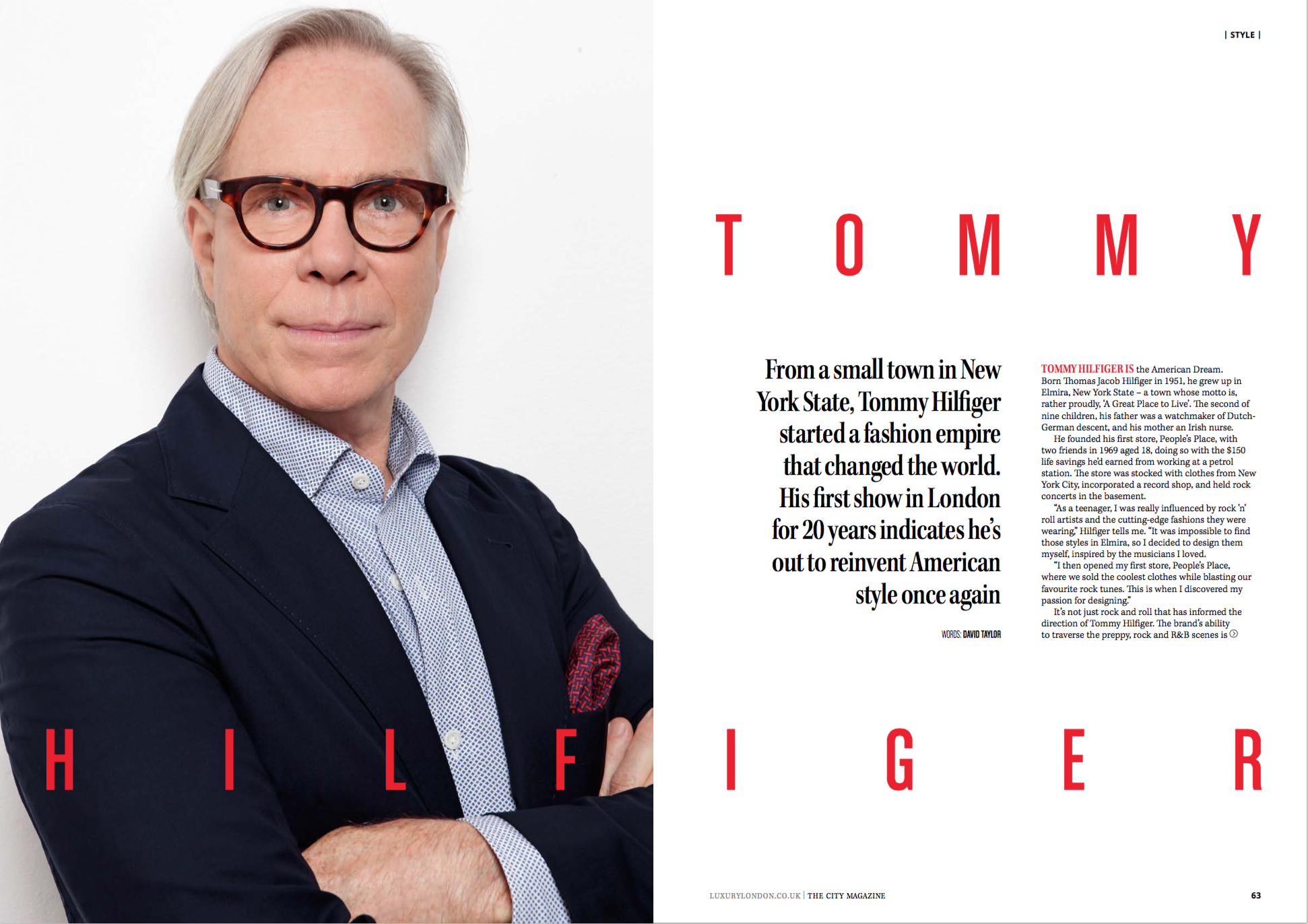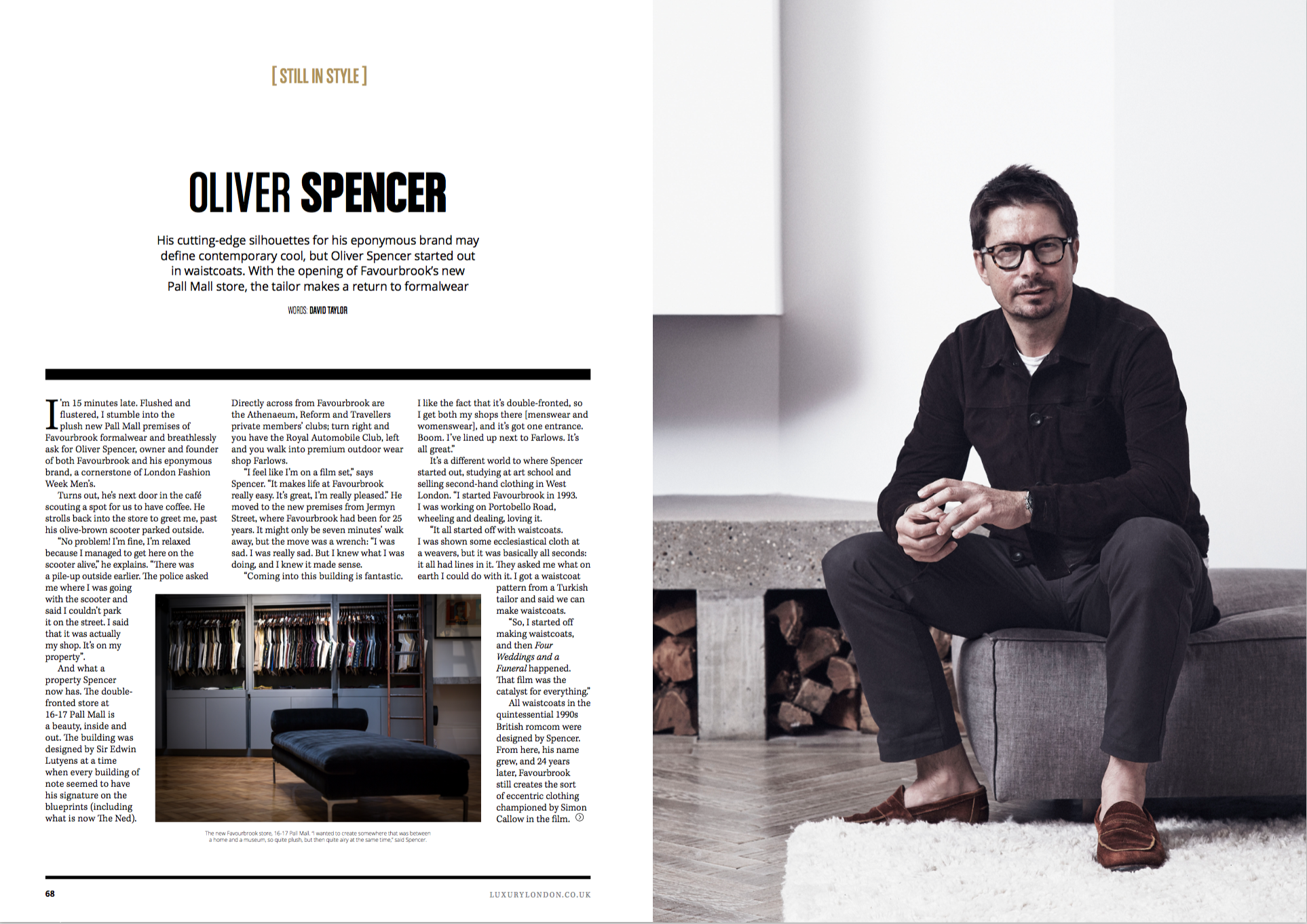The cutting-edge silhouettes for his eponymous brand may define contemporary cool, but Oliver Spencer started out in waistcoats. With the opening of Favourbrook’s new Pall Mall store, the tailor makes a return to formalwear
I’m 15 minutes late. Flushed and flustered, I stumble into the plush new Pall Mall premises of Favourbrook formalwear and breathlessly ask for Oliver Spencer, owner and founder of both Favourbrook and his eponymous brand, a cornerstone of London Fashion Week Men’s.
Turns out, he’s next door in the café scouting a spot for us to have coffee. He strolls back into the store to greet me, past his olive-brown scooter parked outside.
“No problem! I’m fine, I’m relaxed because I managed to get here on the scooter alive,” he explains. “There was a pile-up outside earlier. The police asked me where I was going with the scooter and said I couldn’t park it on the street. I said that it was actually my shop. It’s on my property”.
And what a property Spencer now has. The double- fronted store at 16-17 Pall Mall is a beauty, inside and out. The building was designed by Sir Edwin Lutyens at a time when every building of note seemed to have his signature on the blueprints (including what is now The Ned).
Directly across from Favourbrook are the Athenaeum, Reform and Travellers private members’ clubs; turn right and you have the Royal Automobile Club, left and you walk into premium outdoor wear shop Farlows.
“I feel like I’m on a film set,” says Spencer. “It makes life at Favourbrook really easy. It’s great, I’m really pleased.” He moved to the new premises from Jermyn Street, where Favourbrook had been for 25 years. It might only be seven minutes’ walk away, but the move was a wrench: “I was sad. I was really sad. But I knew what I was doing, and I knew it made sense.
“Coming into this building is fantastic. I like the fact that it’s double-fronted, so I get both my shops there [menswear and womenswear], and it’s got one entrance. Boom. I’ve lined up next to Farlows. It’s all great.”
It’s a different world to where Spencer started out, studying at art school and selling second-hand clothing in West London. “I started Favourbrook in 1993. I was working on Portobello Road, wheeling and dealing, loving it.
“It all started off with waistcoats. I was shown some ecclesiastical cloth at a weavers, but it was basically all seconds: it all had lines in it. They asked me what on earth I could do with it. I got a waistcoat pattern from a Turkish tailor and said we can make waistcoats.
“So, I started off making waistcoats, and then Four Weddings and a Funeral happened. That film was the catalyst for everything.”
All waistcoats in the quintessential 1990s British romcom were designed by Spencer. From here, his name grew, and 24 years later, Favourbrook still creates the sort of eccentric clothing championed by Simon Callow in the film.
Weddings are still big business, especially at the start of a new year following so many Christmas proposals. For Spencer, it’s a fascinating arena: “It’s an interesting business for us, definitely. You get a wide range, you get whole families and really weird requests. It’s really diverse.
“We’ve made lots of incredibly different things for people over the years. Back in the day we used to make cream frock coats for people to get married in, all types of stuff. Very dandy. And I think it’s going to go back to being dandy.
“There’s a push towards dressing up again, going out and having a good time. I think that’s fantastic.”
‘Fantastic’ is a buzzword for Spencer, as is ‘great’. He’s a man seemingly at ease with himself and the worlds of formalwear and contemporary fashion he simultaneously inhabits. On surface level, it’s hard to see where Favourbrook and Oliver Spencer the brand intersect, but Spencer explains: “Oliver Spencer came out of Favourbrook, when I was wearing corduroy suits on the shop floor and people were loving it.
“They do cross over. There are two velvet jackets in Favourbrook at the moment, one’s green and one’s orange, and they cross from a smoking jacket in there to a bomber jacket in Oliver Spencer. So sometimes I share fabrics. Both companies were all about fabrication – my passion was always fabrication.”
Each topic we discuss resorts back to fabrics. The reason for him going into clothing? “Buying a second-hand suit. It was a sky blue seersucker suit, it was hilarious. Way too big. I just sort of... just heaved it all in, with high-waisted trousers. This was way back in ’89. Popped it on with a pair of sandals, and off I went. I looked ridiculous, but I loved it.”
And of the current state of British menswear? “I enjoy every single bit of it. I enjoy everyone coming together: I think the menswear community is fantastic. It’s going from strength to strength. The menswear community is in a great spot.
“I love coming to work, and I love dressing up. And actually, I’m a shopkeeper at heart, so I love being on the shop floor serving.”
With that, Spencer is due at another appointment. Diplomatically, he says: “We’re all running a bit late this morning”, pays for our coffee, shakes my hand, and strolls away tapping at his smart phone, working out where next for Mr Spencer and his olive scooter.
60 seconds on... London and Brexit
Restaurants are facing problems with staffing in the light of Brexit uncertainties. Is it the same in clothing?
OS: Not at the moment, not yet. But it’s got to worry us all. I’m much more worried actually by the disenfranchisement of the youth in London full stop. I think London is not a place for young people anymore. It’s a really big issue. No-one can afford to live here, and not many of us can afford to go out here, either. I’m talking about the under-25s here, really right at the beginning. It’s just really difficult.
Will that affect London’s creative scene?
OS: I think it will have a massive side effect. I don’t want London to become like New York, with streets and streets of empty shops. That’s because everything is over-rented, nobody can afford anything.
Will the cost of operating a business in London stifle entrepreneurship?
OS: I think it will... I think it probably did for me on Jermyn Street already. The rent there now is astronomical. It never used to be, it used to be at a level where people like you and I could afford it. Now I’ve made a stand. One thing I was determined not to do is to work for the landlord. First of all, I work to pay my wages, then I work for the landlord, then eventually, if there’s anything left, we get something. But it’s in that order, and now, the order’s wrong.
What’s your focus for the coming year?
OS: I’ll be focusing on dealing with Brexit, dealing with the hangover of that, and seeing what the hell goes on with my Portuguese manufacturing place. That’s my next big worry. There’s all this to-ing and fro-ing with all the politicians. To be honest, I don’t know how much we’re going to notice Brexit in London. It’s interesting that the Germans and French think they’re going to benefit. I don’t think it’s going to happen. The guys that I know in the City just laugh when I ask them about it. There are 450,000 people working in London’s financial districts. Frankfurt and Paris don’t have the infrastructure. They’re way off.












